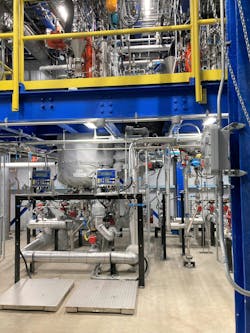During the height of the COVID-19 pandemic, Akzo Nobel struggled to achieve 50% on-time delivery in the U.S. from its suppliers, says Nate Norris, the company’s North America manufacturing and supply chain director.
“One out of every two batches or orders came in on time,” recalled Norris during a visit to the company’s metal and packaging R&D center in Strongsville, Ohio.
As of November, on-time delivery had improved, reaching the mid- to upper-60% range for the Dutch paint and coatings manufacturer, Norris says. While it’s still less than ideal, it’s an improvement nonetheless and a testament to the company’s supply chain planning strategy. The pandemic is just one of many factors reshaping the way chemical manufacturers like Akzo Nobel manage their partner network.
The industry is also contending with environmental concerns within its supply chain, with a specific focus on limiting Scope 3 emissions and addressing chemicals of concern, such as per-and polyfluoroalkyl substances (PFAS). Scope 3 refers to indirect emissions that occur in the value chain, including both upstream and downstream activities.
The evolving landscape further emphasizes the need for the industry to adapt to demand shifts influenced by changing consumer behavior and industry priorities. Chemical producers are now recalibrating their strategies to navigate erratic demand fluctuations, with an emphasis on agile production approaches, supplier diversification and reshoring initiatives to meet market needs, notes Frank Jenner, Ernst & Young’s global chemicals and advanced materials industry leader.
“Priorities now include boosting domestic production, reducing reliance on risky sources and reimagining lean inventory strategies to navigate volatile market dynamics,” Jenner explained in an email interview.
He added that digitalization is a top priority for chemical manufacturers as they retool their supply chains, leveraging technologies like the Internet of Things (IoT) and artificial intelligence (AI) for enhanced supply chain visibility.
Chemical Supply Chain Outlook and Challenges
The regulatory vise on chemical manufacturers continues to tighten, with many new laws impacting material sourcing and tracking to ensure compliance. Many of these standards require substantial investments in monitoring systems, training and documentation, Jenner says. For example, in October the EPA removed an exemption for manufacturers of products containing PFAS, which previously allowed them to avoid reporting products with minimal PFAS amounts. This may have a far-reaching impact on the chemical supply chain, as many of these manufacturers will have to phase out production or find alternate materials.
The American Chemistry Council (ACC) says the industry is increasingly overburdened with regulations, with 55% of its members reporting that their regulatory burden was higher in the third quarter of 2023 than it was in the previous three-month period, according to ACC’s Chemical Manufacturing Economic Sentiment Index. The industry is also trying to address Scope 3 emissions to meet net-zero goals as called for in the Paris Agreement. Many companies are struggling to identify the best ways to calculate greenhouse gas emissions from their value chains and how to gather the data.
Other factors impacting the chemical supply chain include uncertain raw-material availability and pricing, notably petrochemicals, Jenner says. Also, many chemical industry customers are still working through safety stock levels they built up during the pandemic to hedge against further disruptions.
Securing Critical Materials
Challenges around material availability means chemical manufacturers need to build redundancies into their supply chain, says Matt Hoffman, vice president of product and industry solutions for forecasting and supply chain planning software provider John Galt Solutions Inc. That doesn’t mean accumulating costly safety stock on high-demand ingredients or materials.
“It’s really about building in smart redundancy,” Hoffman says.
This involves creating common recipes across production facilities to enable the movement of raw materials between plants, allowing for adaptability during shortages, Hoffman explains. The goal is to minimize unique recipes for each plant, which hinders redundancy. Flexibility in recipes is crucial for addressing regulatory changes or sustainability requirements. While acknowledging the difficulty of altering well-established recipes, chemical manufacturers can identify key materials that allow for changes and determine which recipes and products can be modified based on customer acceptance, Hoffman says.
Overcoming this challenge involves assessing the feasibility of substitutions, adjusting product blends or grades and understanding the capabilities of different facilities. In essence, the tactic is to strategically introduce flexibility in recipes where feasible while recognizing the inherent difficulty in implementing changes for certain materials, Hoffman adds.
Akzo Nobel addresses some of these issues with a robust business continuity strategy. The company prioritizes having a main supplier and a backup supplier for critical raw materials used in high-revenue coatings, Norris says.
The procurement team helps the company evaluate the importance of each raw material in terms of business revenue rather than just volume, ensuring a comprehensive understanding of supply chain dependencies. For example, resins and fillers that the company uses in its coatings are always needed. But there are other materials that Norris calls “fairy dust,” specialized ingredients used in small quantities. Previously, the company might not have bought these materials in large volumes due to infrequent use. Now, it assesses the materials based on revenue, opting for higher-volume purchases for high-revenue products. The company also evaluates additional suppliers to ensure they have ample availability.
Hoffman described similar approaches, with more chemical companies trying to gain a better understanding of their customers’ needs, including which ones might accept different grades of materials and products with longer lead times. The overarching strategy is to optimize the cost to serve specific customers while ensuring profitability, he adds.
“So they could put together a plan that services and really stratifies their different customers so the plan is right, whether it’s substitution at the finished-goods level or, again, different lead times,” Hoffman says.
Turning Suppliers Into Partners
To further secure business continuity, Akzo Nobel engages in detailed discussions with suppliers, including exploring dual sourcing within the supplier's own company and assessing its manufacturing locations, capacities and lead times.
“It’s a partnership. “Before, in the old days, you would see people yell at their suppliers; that’s not helpful,” Norris explains. “Today, we really work with them and ask, ‘How do we help you? Do you need a better demand forecast from us?’”
The continuity plan helps the company shift from firefighting approaches, such as finding a supplier at the last minute or passing their problems on to customers, to long-term strategies for sustained success.
“When we firefight, we find a way to supply the customer, and the customer is happy, but that firefighting doesn’t lead to long-term solutions and really setting ourselves up to win,” Norris says.
Companies increasingly rely on their procurement teams to develop a hedging strategy that includes mid- to long-term price agreements, ensuring a guaranteed supply of material and spot buy, whenever possible, to take advantage of market softening, Hoffman says. These strategies often include scenario planning that allow them to select certain suppliers or quantities based on current market conditions, Hoffman says.
Collaboration with suppliers is particularly important to comply with regulatory changes. Akzo Nobel has launched several coatings that are free of bisphenols, including bisphenol A (BPA) in anticipation of European Food Safety Authority restrictions.
“You've got to be prepared,” Norris says. “What could be coming next? What's the next chemical of concern that people don't want to have in their products? And so, you better have a pretty good technology roadmap for where you want to go.”
Reformulating an established product requires communication between the R&D team and suppliers to identify available materials and capabilities.
“We might need them to design a new resin or help us design a resin,” Norris says. “They might not actually have one on the shelf that's the exact right fit for what we have, so then we ask them to do some R&D work, and we do that with them.”
Chemical Supply Chains Go Digital
Digital technologies offer the transparency and insight necessary for organizations to optimize their supply chains in volatile times. Manufacturers are combining artificial intelligence with traditional planning tools to enable end-to-end visibility in real-time.
Many of these tools, such as machine learning and AI, are now well integrated into many statistical forecasting tools, vastly expanding the breadth of information accessible to decision-makers.
“Now, instead of going through a couple of data points for three years of history, what you’ll see are millions of data points across years and years and years of history, both from the forecasting side but also on the supply side,” Hoffman says.
From a forecasting perspective, the insights tie together different macroeconomic factors, commodity pricing, customer demand, including regional factors, he adds. One of John Galt’s customers used machine learning and AI to identify leading indicators for supply chain disruptions. The system identified increasing lead times, higher commodity prices and declining order fulfillment rates as top warning signs.
“It was able to identify that when there’s this intersection of longer lead times, diminishing fill rate and increasing prices, those were the leading indicators of a supply disruption,” Hoffman says.
A new twist in the digitalization discussion is generative AI. Scenario planning is one area in which generative AI offers significant advantages, says Matthew Reymann, global vice president of chemicals for ERP software company SAP. It can help manufacturers understand the impacts of their decisions. For instance, they can query the system and ask questions about external factors like their end-user markets to help with their decision-making process.
It's unlikely that generative AI will completely automate supply chain planning for manufacturers, says Reymann. But he sees it as a tool that will augment the process and provide more actionable information about upstream and downstream factors.
“If I’m a planner and can quickly distill a tremendous amount of data into 10 points, now I’m applying my critical thinking skills that I’m trained on to make the most profitable decisions for my organization,” Reymann explains.
In addition to internal networks, some chemical manufacturers are joining consortiums that standardize data sharing among supply chain partners. In a previous column, Reymann pointed to the Catena-X Automotive Network. The goal of Catena-X is to establish an open ecosystem that allows vehicle manufacturers and suppliers, including chemical companies like BASF and Henkel, to collaborate using a consistent standard for sharing information and data across the entire automotive value chain.
In January 2023, BASF and Henkel announced the formation of Cofinity-X, along with several auto OEMs and SAP. Cofinity-X extends the Catena-X principles to the European market. The goal of Cofinity-X is to operate an open marketplace for applications and provide products and services to enable the efficient and secure exchange of data among participants. It includes carbon traceability components as well as an intelligent business partner data management function that cleans and enriches business partner data across the automotive supply chain.
“As the leading chemical supplier to the automotive industry, we see tremendous opportunities in operating an ecosystem based on standardized digital services and harmonized data models," said Markus Kamieth, an executive board member at BASF SE, at the time of the announcement. "This will strengthen supply chain resilience, improve transparency and accelerate the transformation towards circularity and net zero carbon footprints across many material categories."
The development of such business networks reflects the evolving dynamics of the chemical industry, where companies acknowledge that their optimal strategy for enhancing customer value lies in competing within a larger ecosystem rather than in direct competition with individual companies, Reymann noted in his column.
“The more we can share across that value chain, certainly in a safe, secure manner, the more effective we can weather disruption,” Reymann says.





